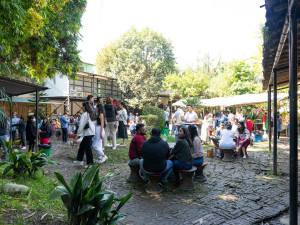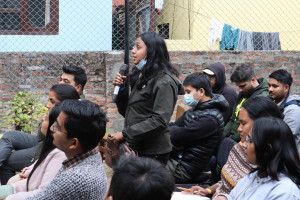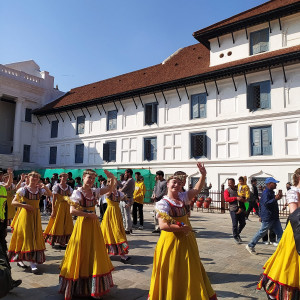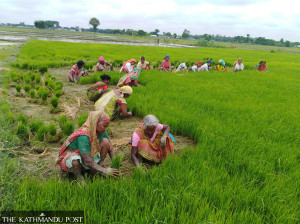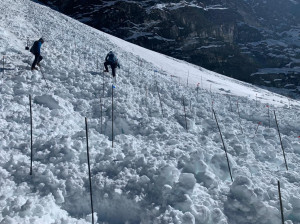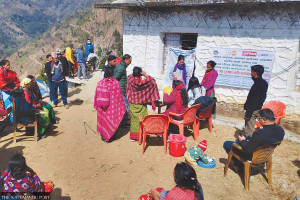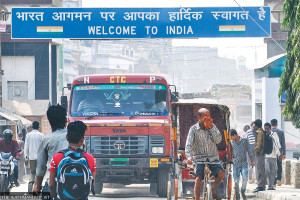 16.12°C Kathmandu
16.12°C KathmanduCulture & Lifestyle
The many ghats of Varanasi
Seema Sharma Shah’s series ‘NAMAMI GANGÉ’ focuses on the Ganga river and its natural flow downwards from the Himalayas.
Anish Ghimire
Creative minds create for many reasons. A few pour what they are feeling, a few are fond of expressing their ideas and others leave tracings of how they view the world in their works. Seema Sharma Shah has been creating for a long time and has similar reasons. “I began painting a lot earlier while growing up,” she says as she walks me through her exhibition, ‘NAMAMI GANGÉ’ at the Siddharta Art Gallery.
This series is the product of her nostalgic memories at Varanasi growing up. “I made these paintings to revisit my youth,” she tells me. In this series, she has focused on the Ganga river and its natural flow downwards from the Himalayas. Varanasi has more than eighty ghats, and these became the subject of her journey to craft her passion for painting. “This was a city that had made me into an artist through years of training and practice that I had completed at the ghats on Ganga’s shore,” she says.
Each ghat on the bank of the Ganga has extreme beauty to capture in the eyes of Shah. This is why we see different elements from many ghats in one frame in her ‘NAMAMI GANGÉ’ series. She chose what she believed to be appropriate from various ghats to create one artwork. Such artworks create a series of eye-catching views of the Ganga and on its bank stand the historic architectural marvels.
Many years later, recalling the Ganga as the inspiration behind her artistic career, she started to paint these ghats for the series. As she began to do so, she saw a great newness in them. “I would sketch the same ghats every day, again and again, and yet I remember that I would see something new each time. A river never looks the same twice,” she says. Every time she looked, she saw something new, which for many could be the same and old; the Scindia Mandir, its sky lamps, large ritual umbrellas, pundits at prayers, the shadow that the sunrise casts through the temples on the river, people on its shore are and never were stagnant.
In many boats that float on the Ganga in Varanasi, advertisements have been pasted on them. Explaining this she says, “These advertisements (in my pieces) are a point where the modernity meets the ancient.” In the background, there are buildings and temples drawn, and in the bottom centre, we see many boats floating, which have been commercialised for the sake of business. This commercialisation hasn’t been taken as a reason that dilutes the aesthetic of the river. She has used this as a way to express that though the temple stays the same, the time moves on. The world turns pages every day, and it is more modern today than it was yesterday.
For Shah, every ghat is special, which is why we see bits of every ghat in her canvases. She spent a lot of time sitting on the banks of the Ganga, early in the morning, using the dusk light to capture the peculiar nature of these ghats. According to her, each one is unique—some have an architecture that leans and bends, some have spacious, well-organised courtyards and staircases, some are used for prayer, some are used for grief and cremation ceremonies, and others are dedicated to the devotees’ bathing and clothes washing.

Upon looking at this series, I saw very few portrayals of people. A ghat is usually buzzing with people—some are there to cremate their loved ones, some are there for prayer, while others fix their gaze at the Ganga, watching the river silently pass by. When I asked the reason for her portrayal of ghats looking a bit deserted, she gave a simple response, “Very few people are up at the first light of dusk.”
This is the reason why most of her works in this series have a sort of dark vibe to them, just like how dusk approaches the day. The hour before the sunrise is hazy and our vision sees the world dimly.
To make these works lifelike, she uses the colour viscosity printmaking method, which makes print sheets out of zinc plates and nitric acid. The works are then printed on 300 gm Canson paper.
In another series, where the central figure is Lord Buddha, she has included many stories surrounding Buddha in her works. One of the most eye-catching ones is titled, ‘Maha Daan’, where we see Buddha, after receiving enlightenment, return to his palace as a monk and ask for bhiksha (a tradition of asking for alms). In the same frame, Yasodhara is seen with her son, and she gives her son as alms. “That is because she has nothing more valuable than her son,” explains Shah.
Such detail and storytelling is appreciated by Sangeeta Thapa, the founder of the gallery who says, “Shah’s works are ambitious and powerful for their unrivalled scale and vision. She remains a purist at heart, laboriously etching into the zinc plate by hand, undaunted by new trends, striving to attain the viscosity in each of her etchings,”
In another series titled the ‘Deity’, Shah portrayed many forms of gods worshipped in Kathmandu. She recalls that when she first moved to Kathmandu in 1995, she was fascinated by the various forms of worship that were practised here. “The daily worship of the Sun, Vishnu, Shiva, and his son Kumar, the prayer flags on house roofs, the ceremonial sacrifices performed in the morning, and the red ritual markings on household entrances outside were all unlike anything I had seen in India,” she says.
This buzzing religious atmosphere in the nation’s capital captured Shah’s heart and this gave birth to the Deity series. “I remember being fascinated by the story of Kumari,” she says. In one of her earlier paintings, she had painted Kumari, who was peeking out from her room and had her eyes covered and the people were watching her from downstairs. “With that, I wanted to show that, the world could see Kumari but she could not see the world,”
She was also fascinated by seeing many Jatras in Nepal. “I was amazed to see that many gods and goddesses in the city were taken outside of their temples and paraded across the city. Gods had such a wanderlust, I thought,” she shares.
In this series, Shah has brought many deities to life, with her intricate works and attention to detail. Every corner and centre has something to say and is filled with colours of her admiration of gods. In this series, the colours ooze out of the canvas unlike the misty vibe carried by the ‘NAMAMI GANGÉ’ series.

Colourful or not, Shah’s skill in portraying the beauty and significance of religion and culture shines brightly in her work.
NAMAMI GANGÉ
Where: Siddhartha Art Gallery, Baber Mahal Revisited, Kathmandu
Timings: 11:00 am to 5:00 pm, On Saturday: 12:00 pm to 5:00 pm
Till March 11







.jpg&w=200&height=120)




